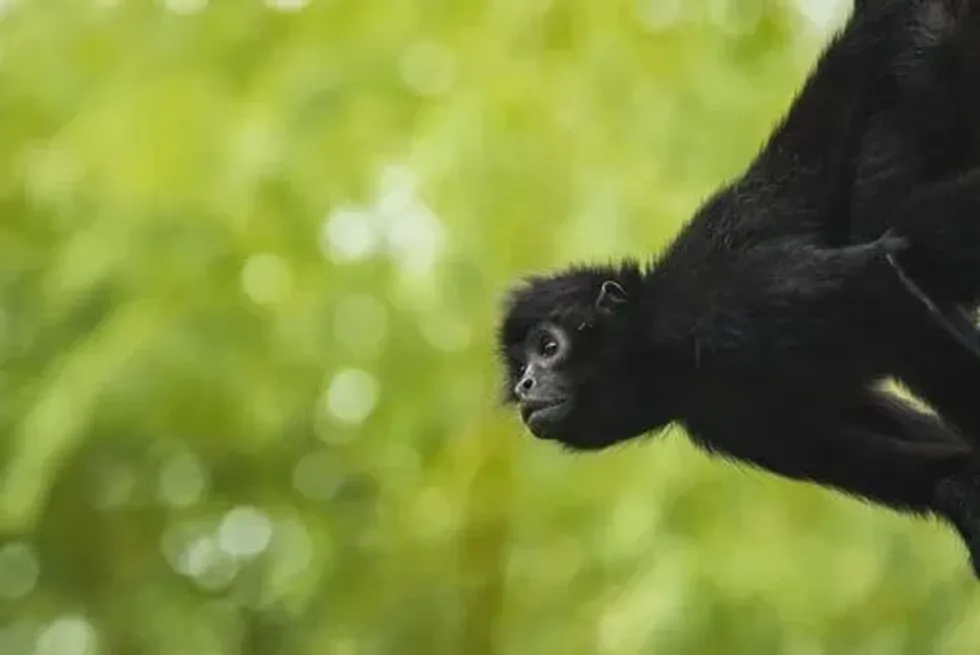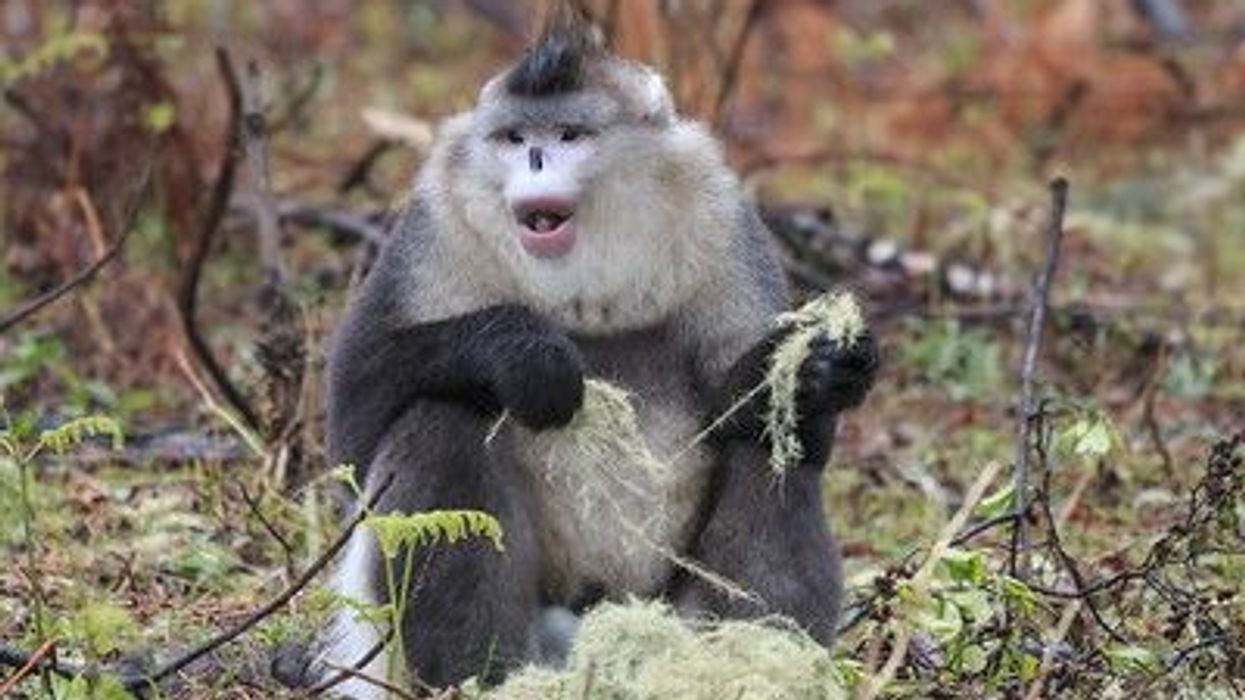Spider monkeys belong to the group of New World monkeys, which also includes capuchins and squirrel monkeys. Belonging to the genus Ateles and family Atelidae, all spider monkeys are found in the tropical and subtropical forests of South and Central America.
The genus Ateles contains a total of seven species and subspecies, including Geoffroy's spider monkey (Ateles geoffroyi).
Spider monkeys are known for their distinctively long limbs, and a prehensile tail, rightly called the fifth limb. Unfortunately, all members of the genus are under severe threat, with some being even Critically Endangered.
The black-headed spider monkey (Ateles fusciceps) is native to Central and South America. It is a resident of Ecuador, Colombia, and Panama and is one of the seven species of spider monkeys found in Latin America.
This species is the largest primate found in South America. It has two subspecies, the brown-headed spider monkey (A. f. fusciceps) and the Colombian spider monkey (A. f. rufiventris).
Brown-headed spider monkeys are found in northwestern Ecuador and are a Critically Endangered species. The Colombian subspecies, found in Colombia and Panama, are Vulnerable.
Black-headed spider monkeys feed on a diet of nuts, seeds, insects, tree leaves, ripe fruits and spend most of their time atop tree branches. Members of the species usually form loose groups.
Read on to know more about these spectacular tree-dwelling animals of Latin America! You can also learn about other animals such as the black lemur and mongoose lemur.
Black-headed Spider Monkey Interesting Facts
What type of animal is a black-headed spider monkey?
The black-headed spider monkey (scientific name: Ateles fusciceps) is a primate and a New World monkey of the family Atelidae.
What class of animal does a black-headed spider monkey belong to?
Black-headed spider monkeys belong to the class of mammals.
How many black-headed spider monkeys are there in the world?
An estimate of the total population size of black-headed spider monkeys is not available. As per the black-headed spider monkey Red List status, the species has a globally decreasing population trend.
Where does a black-headed spider monkey live?
The black-headed spider monkey geographic distribution is limited to Central and South America, particularly Ecuador, Colombia, and Panama. In particular, the subspecies, brown-headed spider monkey, is found in northwestern Ecuador, and the Colombian spider monkey is found in Colombia and Panama.
What is a black-headed spider monkey's habitat?
The general habitat of black-headed spider monkeys includes the tropical and subtropical rainforests of South and Central America.
While the habitat of the Critically Endangered brown-headed spider monkey includes humid tropical and subtropical forests, the Colombian subspecies inhabits humid forests, dry forests, and cloud forests. The brown-headed subspecies are found at elevations of 330-5580 ft (100.6-1700.8 m) above sea level, and the Colombian ones inhabit higher altitude zones of 6600-8200 ft (2012-2500 m) above sea level.
In their natural habitat, these animals spend most of their time traveling from tree to tree, foraging for food.
Who do black-headed spider monkeys live with?
The black-headed spider monkeys form loose groups of up to 20 animals and keep moving between subgroups of various sizes. The male members do not leave their respective maternal group in their entire lifetime.
On the other hand, the females disperse from their maternal group on reaching adolescence and join new groups. Since the males generally stick together for their entire lives, they are more likely to form close bonds compared to the females. The females form strong social bonds with their young offspring.
Being diurnal, they sleep at night and are active during the day. These animals use both their hands and feet to sway from tree to tree and walk upright along branches.
How long does a black-headed spider monkey live?
The lifespan of black-headed spider monkeys in the wild is unknown. Captive individuals have a lifespan of about 24 years.
How do they reproduce?
Female black-headed spider monkeys undergo an estrus cycle of about 26 days, during which they are ready to mate. There is no definite breeding season.
Post mating, these female monkeys undergo a gestation period of about 227 days and, at the end of it, give birth to a single offspring.
The young are weaned at the age of about 20 months and are taken care of, solely by the female parent. While female black-headed spider monkeys attain sexual maturity in 1,515 days, the male does so in about 1,826 days.
What is their conservation status?
As per the International Union for Conservation of Nature (IUCN) Red List of Threatened Species, black-headed monkeys are an Endangered species. The brown-headed subspecies are Critically Endangered, and Colombian spider monkeys are Vulnerable.
Black-Headed Spider Monkey Fun Facts
What do black-headed spider monkeys look like?
Black-headed spider monkeys have disproportionately long limbs. A prehensile tail serves as the fifth limb and helps these arboreal animals to hold on to objects and travel across trees as they forage for food.
The tail is longer than the total body length. The monkey's coat hair is long and shaggy, with a whitish ring surrounding each of its two eyes.
The hands and feet of these animals are perfectly suited to an arboreal lifestyle. In addition, the absence of a thumb increases their gripping power and aids in climbing.
The brown-headed subspecies have a brown head and a brownish-black body. In contrast, the Colombian subspecies are entirely black, apart from a few strands of white hair on the chin.
 We've been unable to source an image of a black-headed spider monkey and have used an image of a spider monkey instead. If you are able to provide us with a royalty-free image of a black-headed spider monkey, we would be happy to credit you. Please contact us at hello@kidadl.com.
We've been unable to source an image of a black-headed spider monkey and have used an image of a spider monkey instead. If you are able to provide us with a royalty-free image of a black-headed spider monkey, we would be happy to credit you. Please contact us at hello@kidadl.com.
How do they communicate?
In general, spider monkeys use various postures and stances to communicate their intentions. For example, these monkeys react to approaching humans by barking like a dog. Adult males and females may also growl or defecate and urinate at the sight of intruders.
How big is a black-headed spider monkey?
On average, the head and body length of a black-headed spider monkey ranges between 16-22 in (41-56 cm). The tail adds another 28-34 in (71-86 cm). Overall, they are smaller than howler monkeys.
How fast can a black-headed spider monkey move?
No information is available regarding the exact movement speed of black-headed spider monkeys. However, these animals are known to take leaps of over 30 ft (9 m) while moving from branch to branch.
How much does a black-headed spider monkey weigh?
The average weight for both males and females is 19.8 lb (9 kg). When compared to squirrel monkeys or capuchins, they are significantly heavier.
What are the male and female names of the species?
Male and female monkeys do not have specific names.
What would you call a baby black-headed spider monkey?
A baby monkey is simply called an infant.
What do they eat?
Black-headed spider monkeys are primarily herbivores, and their diet consists of mainly plant material. The diet includes tree leaves, ripe fruits, nuts, and seeds. Besides, insects and eggs also occasionally form a part of their diet.
Are they dangerous?
While black-headed spider monkeys are seemingly harmless, spider monkeys, in general, tend to growl and defecate at human intruders.
Would they make a good pet?
Since the black-headed spider monkey is a wild animal, it is best not to try and pet it since it may become aggressive around humans. Besides, the species is Endangered and listed in Appendix II of CITES, and it would be illegal to keep one as a pet.
Did you know...
The Atelidae family also includes howler monkeys and woolly monkeys.
The Ancient Greek meaning of 'Ateles' is 'imperfect or incomplete', referring to the absence of a thumb in a spider monkey.
Why is the black-headed spider monkey endangered?
Habitat loss due to deforestation, hunting, and fragmentation are the primary causes attributed to black-headed spider monkeys becoming Endangered.
Why is it called black-headed spider monkey?
Depending on the subspecies, a black-headed spider monkey either has a brownish or a blackish head, hence the name. Besides, the term spider in their name comes from the fact that these monkeys with their long limbs and tail look like spiders when dangling upside down from trees.
Here at Kidadl, we have carefully created lots of interesting family-friendly animal facts for everyone to discover! For more relatable content, check out these colobus monkey facts and brown spider monkey facts for kids.
You can even occupy yourself at home by coloring in one of our free printable bale monkey coloring pages.




 We've been unable to source an image of a black-headed spider monkey and have used an image of a spider monkey instead. If you are able to provide us with a royalty-free image of a black-headed spider monkey, we would be happy to credit you. Please contact us at hello@kidadl.com.
We've been unable to source an image of a black-headed spider monkey and have used an image of a spider monkey instead. If you are able to provide us with a royalty-free image of a black-headed spider monkey, we would be happy to credit you. Please contact us at hello@kidadl.com.



